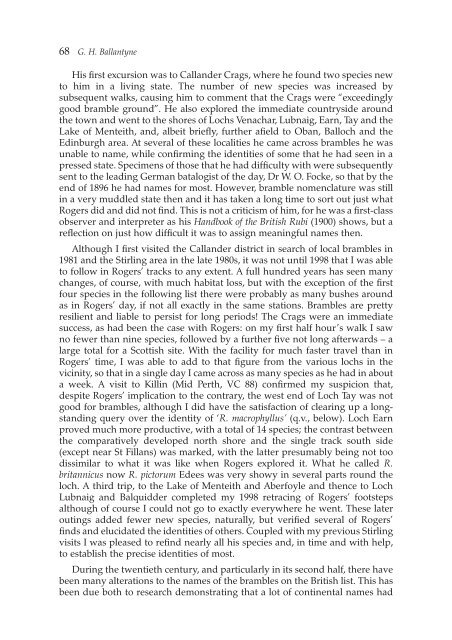the Forth Naturalist Historian - Forth Naturalist and Historian ...
the Forth Naturalist Historian - Forth Naturalist and Historian ...
the Forth Naturalist Historian - Forth Naturalist and Historian ...
Create successful ePaper yourself
Turn your PDF publications into a flip-book with our unique Google optimized e-Paper software.
68 G. H. Ballantyne<br />
His first excursion was to Call<strong>and</strong>er Crags, where he found two species new<br />
to him in a living state. The number of new species was increased by<br />
subsequent walks, causing him to comment that <strong>the</strong> Crags were “exceedingly<br />
good bramble ground”. He also explored <strong>the</strong> immediate countryside around<br />
<strong>the</strong> town <strong>and</strong> went to <strong>the</strong> shores of Lochs Venachar, Lubnaig, Earn, Tay <strong>and</strong> <strong>the</strong><br />
Lake of Menteith, <strong>and</strong>, albeit briefly, fur<strong>the</strong>r afield to Oban, Balloch <strong>and</strong> <strong>the</strong><br />
Edinburgh area. At several of <strong>the</strong>se localities he came across brambles he was<br />
unable to name, while confirming <strong>the</strong> identities of some that he had seen in a<br />
pressed state. Specimens of those that he had difficulty with were subsequently<br />
sent to <strong>the</strong> leading German batalogist of <strong>the</strong> day, Dr W. O. Focke, so that by <strong>the</strong><br />
end of 1896 he had names for most. However, bramble nomenclature was still<br />
in a very muddled state <strong>the</strong>n <strong>and</strong> it has taken a long time to sort out just what<br />
Rogers did <strong>and</strong> did not find. This is not a criticism of him, for he was a first-class<br />
observer <strong>and</strong> interpreter as his H<strong>and</strong>book of <strong>the</strong> British Rubi (1900) shows, but a<br />
reflection on just how difficult it was to assign meaningful names <strong>the</strong>n.<br />
Although I first visited <strong>the</strong> Call<strong>and</strong>er district in search of local brambles in<br />
1981 <strong>and</strong> <strong>the</strong> Stirling area in <strong>the</strong> late 1980s, it was not until 1998 that I was able<br />
to follow in Rogers’ tracks to any extent. A full hundred years has seen many<br />
changes, of course, with much habitat loss, but with <strong>the</strong> exception of <strong>the</strong> first<br />
four species in <strong>the</strong> following list <strong>the</strong>re were probably as many bushes around<br />
as in Rogers’ day, if not all exactly in <strong>the</strong> same stations. Brambles are pretty<br />
resilient <strong>and</strong> liable to persist for long periods! The Crags were an immediate<br />
success, as had been <strong>the</strong> case with Rogers: on my first half hour’s walk I saw<br />
no fewer than nine species, followed by a fur<strong>the</strong>r five not long afterwards – a<br />
large total for a Scottish site. With <strong>the</strong> facility for much faster travel than in<br />
Rogers’ time, I was able to add to that figure from <strong>the</strong> various lochs in <strong>the</strong><br />
vicinity, so that in a single day I came across as many species as he had in about<br />
a week. A visit to Killin (Mid Perth, VC 88) confirmed my suspicion that,<br />
despite Rogers’ implication to <strong>the</strong> contrary, <strong>the</strong> west end of Loch Tay was not<br />
good for brambles, although I did have <strong>the</strong> satisfaction of clearing up a longst<strong>and</strong>ing<br />
query over <strong>the</strong> identity of ‘R. macrophyllus’ (q.v., below). Loch Earn<br />
proved much more productive, with a total of 14 species; <strong>the</strong> contrast between<br />
<strong>the</strong> comparatively developed north shore <strong>and</strong> <strong>the</strong> single track south side<br />
(except near St Fillans) was marked, with <strong>the</strong> latter presumably being not too<br />
dissimilar to what it was like when Rogers explored it. What he called R.<br />
britannicus now R. pictorum Edees was very showy in several parts round <strong>the</strong><br />
loch. A third trip, to <strong>the</strong> Lake of Menteith <strong>and</strong> Aberfoyle <strong>and</strong> <strong>the</strong>nce to Loch<br />
Lubnaig <strong>and</strong> Balquidder completed my 1998 retracing of Rogers’ footsteps<br />
although of course I could not go to exactly everywhere he went. These later<br />
outings added fewer new species, naturally, but verified several of Rogers’<br />
finds <strong>and</strong> elucidated <strong>the</strong> identities of o<strong>the</strong>rs. Coupled with my previous Stirling<br />
visits I was pleased to refind nearly all his species <strong>and</strong>, in time <strong>and</strong> with help,<br />
to establish <strong>the</strong> precise identities of most.<br />
During <strong>the</strong> twentieth century, <strong>and</strong> particularly in its second half, <strong>the</strong>re have<br />
been many alterations to <strong>the</strong> names of <strong>the</strong> brambles on <strong>the</strong> British list. This has<br />
been due both to research demonstrating that a lot of continental names had



